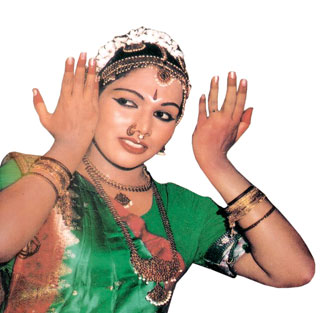Traditional Bharatha Natyam repertoire
Subashini Pathmanathan
The fascination of Bharatha Natyam lies in the uniqueness of its
traditional repertoire. The repertoire of Bharatha Natyam recital was
laid down in the late 19th Century by the Tanjore Quartette namely
Chinniah, Ponniah, Sivanandam and Vadivelu.
|

Sathir dance was performed by Devadasis, handmaids of the Lord |
To this day, the exponents of Bharatha Natyam faithfully follow this
tradition.
The Alarripu, Jetheeswaram, Sabtham, Varnam, Padams, Thillana and
Slokams are the correct sequence in the practice of this art.
is an
artistic yoga revealing the spiritual thoroughness, says Bharatha
Natyam queen Balasaraswathi.
The traditional repertoire is mainly followed in Arangetrams.
Jetheeswaram and Sabtham are omitted in ordinary recitals. Constraints
of time and the desire of audience to leave early are probably the
deciding factors for the omission of these early items.
The Alarippu, the Pure Nirutha dance, which is compiled to Sollukaddu,
based on thala (rhythm) and mingled with Carnatic music, reveals the
beautiful movements of Anga, Upaanga, and Pirathi Anga of the dancer.
Alaripu follows another Nirutha piece called Jetheeswaram, in which
sequence of adavus are interwoven to suit the particular swaras based on
different ragas.
Then follows the Sabtham, which is always based on Misrasaapu thala.
The term Sabtham is a Sanskrit word. Sabtham means seven; for instance
Sabtha Swaras, Sabtha Rishis and Sabtha Thandavam. All these reflect the
influence of Sanskrit. The word Sabtham in dance means seven because it
is in the Misrasaapu Thala, which counts seven thala counts.
During early times Sabtham was called Salaamu, because it was
introduced into Bharatha Natyam during the Muslim rule. Even today many
Sabthams conclude with the word Salaamu.
In dance Alarippu, Jetheeswaram, and Sabtham are based on Carnatic
music, but these are not used in Carnatic music recitals.
The Varnam, in all Classical Bharatha Natyam recitals, follows the
Sabtham. The Varnam which is more suitable for Carnatic music is called
Thaana Varnam. The Varnam often used in Bharatha Natyam is Patha Varnam.
The Patha Varnams are more suitable for abinaya and expressions. Some
Thaana Varnams can be used for dance, provided they are meaningful and
capable of being adopted to dance forms.
The Varnam is followed by Padams, which are melodic compositions. In
the Padams, the dancer implores the God to grant her spiritual
upliftment and eternal bliss. Padams in general provide ample scope for
display of Navarasa.
|

Dancer implores the God to grant her spiritual uplift and
eternal bliss |
Then follows Thillana, which encompasses all the aspects of dance.
This includes brisk adavus, beautiful poses, footwork, excellent
expressions and appropriate abinayas. The finale of the traditional
classical dance recital is the Slokam or Virutham. The Slokam or
Virutham brings spiritual fulfillment to the dancer.
Balasaraswathi says: The Bharatha Natyam recital is structured like
a great temple; enter through Gopuram the (Outer hall) of Alarippu,
cross through Ardhamandapam, (halfway hall) of Jetheeswaram. Then the
Mandapam (the great hall), Sabtham, and enter the holy precinct of the
deity is Varnam.
Bharatha Natyam was originated as temple dance Sathir and moved on to
the palaces, and eventually to concert halls. It is a devotional dance
and to this day, there is an aura of sanctity surrounding this art.
Sathir dance was performed by Devadasis, handmaids of the Lord.
Moreover it was performed as a part of temple rituals, which were
normally performed in the outer courtyard of the temple.
The handmaids who performed in Shivan temples were called
Rishabathali-yea-Laalar, while those who performed in Vishnu temples
were called Sri Vishnavamaanikam.
Except Arengetrams, or even sometimes in the Arangetrams, the
traditional repertoire is often changed. New items such as Ganesher
Anjali, or pushpa Anjali, or panchamoorthy Anjali, or Gurupatha Anjali,
or different Anjalies (tributes) or different Guwthavams on different
Gods of their own selective faith items are given utmost opportunity for
their performances.
Hence, the basic temple structure repertoire, which was laid down in
the 19th Century, is totally changed in the 21st Century Bharatha Natyam
repertoire, mainly in the practical performing field. |



